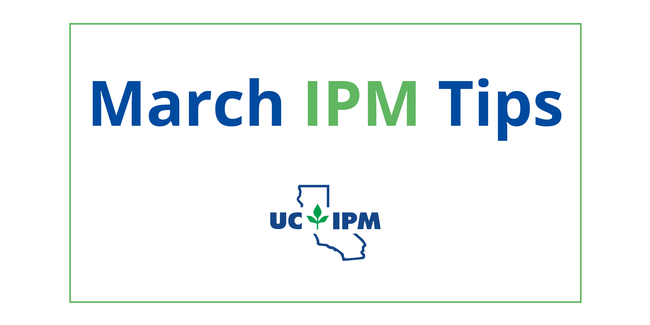Mar 6, 2024
Follow these general tips for the month of March to prevent pests in the garden and landscape. To view more tips specific to your region, visit the Seasonal Landscape IPM Checklist on the UC IPM website.
- Look for aphids and their natural enemies such as predaceous bugs, lacewings, lady beetles, and syrphid flies. On small plants, spray a strong stream of water or apply insecticidal oils or insecticidal soaps to kill them.
- Fertilize caneberries, citrus, deciduous fruit trees, palms, and heavily-flowering shrubs with slow-release products.
- Monitor for the crawler stage of scale insects and apply horticultural oil if scales are abundant.
- Remove weeds as soon as they pop up in the garden or landscape.
- Apply organic mulches where thin or soil is bare under trees and shrubs to prevent weeds and regulate soil moisture and temperature. Keep mulch back from trunks and at a depth of 2 to 4 inches, depending on the mulch type.
- Prevent mosquitoes by eliminating standing water in gutters, drain pipes, flowerpots, etc. Place Bacillus thuringiensis subspecies israelensis in birdbaths and ponds to selectively kill mosquito larvae.
- If olive psyllid was a problem in past years, use an appropriate insecticide when the first generation of psyllids appear.
- Whitewash tree trunks to deter borers and prevent sunburn. Apply to young trees or older bark on susceptible trees newly exposed to sunlight.
- Keep an eye out for codling moth adults on apple and pear. Bag fruit and promptly remove infested or dropped fruit.
- Apply blossom sprays to prevent new fire blight infections. Look for oozing and dead limbs on pome plants such as apple, crabapple, pear, and pyracantha as soon as spring growth begins.
- Check for signs of powdery mildew on apple, crape myrtle, grape, rose, and stone fruits. Take preventative measures, like pruning, to provide better air circulation between plants.
Don't see your county on the checklist or want to provide feedback? Let us know!
Topics:
